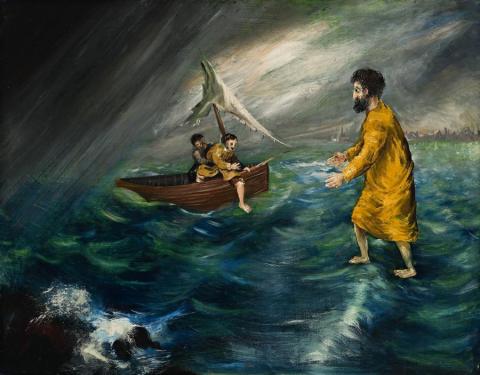CHRIST WALKING ON THE WATER, c.1947-48
ARTHUR BOYD
oil on composition board
67.0 x 85.5 cm
signed lower right: Arthur Boyd
Peter Bray Gallery, Melbourne
John and Sunday Reed, Melbourne
Blue Boy Gallery, Melbourne
Private collection, Adelaide, acquired from the above late 1970s
Arthur Boyd, Peter Bray Gallery, Melbourne, 15–24 September 1953
Philipp, F., Arthur Boyd, Thames and Hudson, London,1967, cat. 3.19, pp. 140, 142, 243
Bungey, D., Arthur Boyd: A Life, Allen and Unwin, Sydney, 2007, pp. 253, 393, 398
Christ Walking on the Water, 1950–52, lead glazes on ceramic, 31.5 x 41.5 cm, collection of the Art Gallery of New South Wales, Sydney
Arthur Boyd's early biblical paintings in oil and tempera found their 'crowning and completion' in The Grange murals of 1948-49.1 Biblical themes continued to appear in his ceramic paintings of 1949-52 and the arresting ceramic sculptures of 1952-53 which followed. Tragically, the mural paintings at Harkaway, with their narratives of The Prodigal Son and Susannah, are now known only through photographs. Of the others, there are many treasured examples in public and private collections. Memorable among the former are The Golden Calf, 1947 in the collection of the Art Gallery of Ballarat, Victoria, and The Expulsion, 1947-48 in the Art Gallery of New South Wales, Sydney. Of the painted ceramics, the related work, Christ Walking on the Water, 1950-52 is also in the Sydney collection, with major ceramic sculptures such as The Thirty Pieces of Silver, 1952-53 in National Gallery of Australia, Canberra, and Saul and David, 1952-53 in the collection of the National Gallery of Victoria, Melbourne. For Boyd, it was a period of much experiment and stunning achievement as he combined the study of the techniques of the Old Masters with the richly creative influences of Bosch, Pieter Bruegel the Elder, Tintoretto, and Rembrandt. The Mining Town (Casting the Money Lenders from the Temple), c1946-47 (National Gallery of Australia), for example, shows the typically high viewpoint and panoramic sweep of Bruegel, peopled with all kinds of activity. Significantly, these paintings were set locally, The Golden Calf within the Berwick landscape, and The Mining Town redolent with such features as Port Phillip Bay and the piers of Port Melbourne. In The Grange murals, the influence of Rembrandt and Tintoretto come to the fore, painted with 'a warm Venetian richness'.2
This 'Venetian affinity', especially that of Tintoretto, continued in Christ Walking on the Water, suggesting that the likely date for the oil painting is the late forties rather than early fifties, as previously given. In his scholarly 1967 catalogue of Boyd's works, Franz Philipp gave a questioned date of 1950-52, with the note - 'The owner believes that the painting is from approximately the same time as the two ceramic paintings (cat. 6.17, 6.23) based on it.' - however, Philipp groups this work in the catalogue of 19 Biblical Paintings, dated 1945-50.3 Boyd only began ceramic painting after the completion of his biblical oil paintings and murals, continuing to explore ideas first presented in the former. While there is a clear relationship between the oil Christ Walking on the Water and the ceramic painting in the Art Gallery of New South Wales, it does not necessarily follow that the latter was produced soon after the oil. This is supported by the example of the oil and ceramics paintings of The Expulsion. Same of title and similar in idea, the oil dates from 1947-48. It was not followed in ceramic until 1950-51. More importantly, the style of the oil painting Christ Walking on the Water suggests a time when the Tintoretto/Venetian influence was at its height.4 This is seen in its freedom of execution, flickering light in the dramatic use of chiaroscuro, emotionally charged brushstrokes, Mannerist ambiguity of space, and the dialogue of hands. The prominence of the yellow garment worn by Christ recalls that of the patriarch in the Prodigal Son and of Susannah in The Grange murals. Moreover, this single, dominant foreground figure is another innovation of 1947-48. Boyd's citing of Melbourne on a watery skyline, gives the work that added validity of an Australian setting, while providing an ironic touch of the Venice of the south.
1. Philipp, F., Arthur Boyd, Thames and Hudson, London, 1967, p. 56
2. Ibid, p. 56
3. Ibid, p. 243
4. Of Tintoretto Philipp noted '... whose influence on Boyd's art had been in ascendancy for some years; it reaches its greatest fullness in The Grange murals.' Ibid, p. 56
DAVID THOMAS
